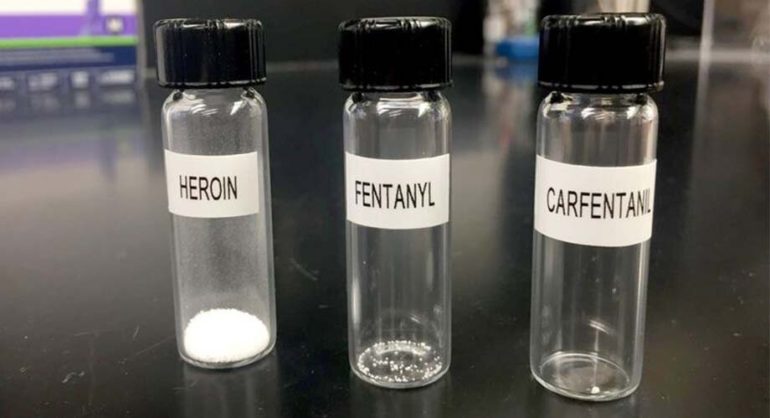As the opioid epidemic raged on with an even greater force during COVID-19, the Scripps Research laboratory of chemist Kim Janda, Ph.D., has been working on new therapeutic interventions that may be able to prevent the bulk of deaths from opioid overdose.
Janda and his team have developed experimental vaccines that have shown in rodents to blunt the deadly effects of fentanyl—which has been driving the boom in opioid deaths—as well as its even more fatal cousin, carfentanil, a growing source of overdoses and a chemical terrorist threat.
“Synthetic opioids are not only extremely deadly, but also addictive and easy to manufacture, making them a formidable public health threat, especially when the coronavirus crisis is negatively impacting mental health,” says Janda, the Ely R. Callaway, Jr. Professor of Chemistry at Scripps Research. “We’ve shown it is possible to prevent these unnecessary deaths by eliciting antibodies that stop the drug from reaching the brain.”
Once in the brain, synthetic opioids trigger the body to slow down breathing. When too much of the drugs are consumed, which is easy to do, breathing can stop altogether. In a series of experiments involving mice, Janda’s vaccines “sequestered” the potent drug molecules to keep them from interacting with the brain and body, thus thwarting dangerous respiratory symptoms.
Findings appear today in ACS Chemical Biology.
Janda envisions the vaccine being used in a number of scenarios, including emergency situations to treat overdoses, as a therapy for those with substance abuse disorder, and as a means to protect military personnel who may be exposed to opioids as chemical weapons. They may even be helpful for police dogs that are trained seek out these deadly drugs.
“The respiratory depression data we show is phenomenal for both fentanyl and carfentanil, which brings us hope that this approach will work to treat a number of opioid-related maladies,” Janda says.
A long way from ‘miracle drug’
Opioids are a diverse class of drugs that have been used to relieve pain for more than 200 years, although the landscape has taken a stark turn in recent decades. The pain drug morphine, isolated from opium, was heralded as a miracle drug in the early 1800s. Not long after, drug makers created a synthetic form, heroin, as a supposedly non-addictive morphine substitute. (The problematic nature of the drug became clear in the 1920s, prompting regulation.)
However, it wasn’t until the late 1990s that opioids began to trigger a public health emergency marked by widespread overuse of opioid medications, both from prescriptions and illegal sale of the drugs.
Today, the problem has reached a new crescendo. In December, the Centers for Disease Control and Prevention declared the highest number of overdose deaths ever recorded in a 12-month period, with synthetic opioids—primarily fentanyl, created in illegal labs—as the main source.
Also deemed a terrorist weapon
Fentanyl is much stronger than most other opioids, up to 100 times stronger than morphine. Carfentanil, meanwhile, is up to 10,000 times more potent than morphine, Janda says, making it the deadliest of all. It is often used in veterinary medicine to sedate large animals such as elephants.
Although carfentanil is not as well-known as a street drug, it is an increasingly used as an adulterant in heroin and cocaine, leading to unexpected drug overdoses. It can also lead to overdose deaths from accidental exposure, such as in veterinary or police settings. Having an emergency vaccine on hand can thwart those risks.
Janda says synthetic opioids also are considered a terrorist weapon; they can be made in large quantities and in several forms, including tablets, powder and spray. They are readily absorbed through the skin or through inhalation. A single terrorist attack using carfentanil could be deadly for large numbers of people, he says.
“Unfortunately, the rise in carfentanil and fentanyl overdose incidents is placing further strain on already overwhelmed public health systems currently battling a pandemic,” Janda says. “We look forward to continuing our vaccine research and translating it to the clinic, where we can begin to make an impact on the opioid crisis.”
Vaccine could help address the opioid epidemic
More information:
“A Highly Efficacious Carfentanil Vaccine that Blunts Opioid-Induced Antinociception and Respiratory Depression,” ACS Chemical Biology (2021). pubs.acs.org/doi/10.1021/acschembio.1c00026
Provided by
The Scripps Research Institute
Citation:
Experimental vaccine blunts the deadliest of synthetic opioids (2021, February 4)
retrieved 5 February 2021
from https://phys.org/news/2021-02-experimental-vaccine-blunts-deadliest-synthetic.html
This document is subject to copyright. Apart from any fair dealing for the purpose of private study or research, no
part may be reproduced without the written permission. The content is provided for information purposes only.



